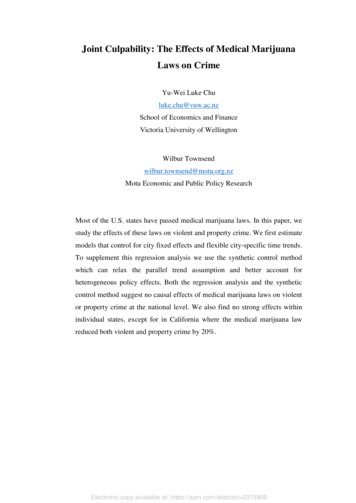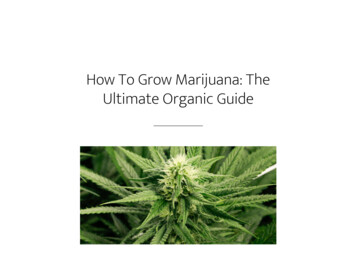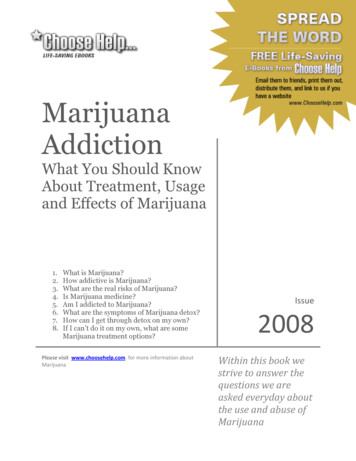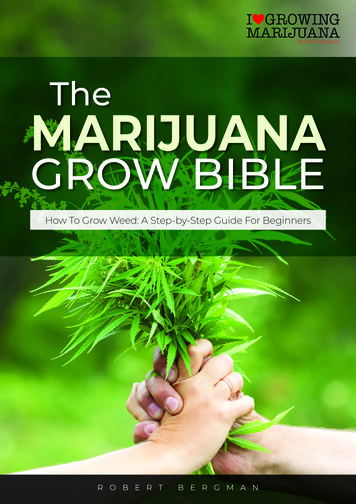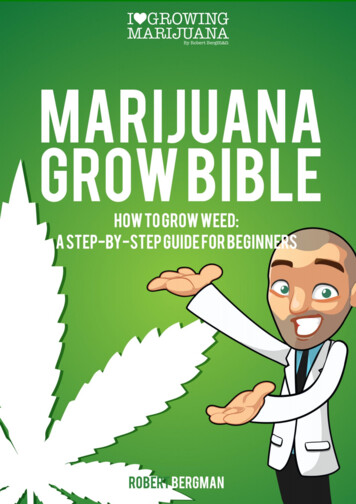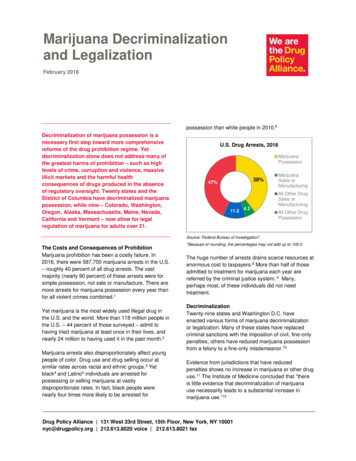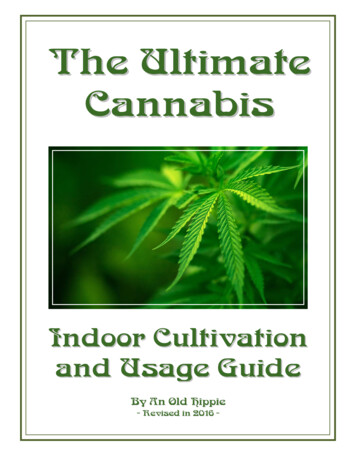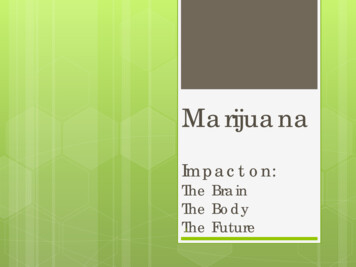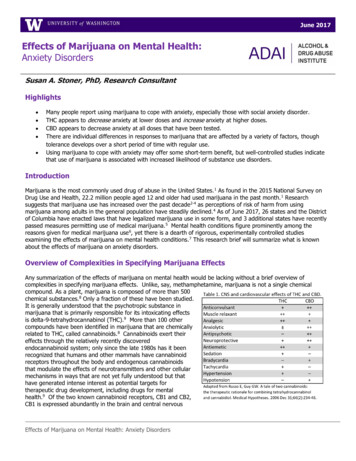
Transcription
June 2017Effects of Marijuana on Mental Health:Anxiety DisordersSusan A. Stoner, PhD, Research ConsultantHighlights Many people report using marijuana to cope with anxiety, especially those with social anxiety disorder. THCappearsto decreaseanxietyFacilitiesat lower doses and increase anxiety at higher doses.ConsideringLockedvs. UnlockedTreatment CBD appears to decrease anxiety at all doses that have been tested. There are individual differences in responses to marijuana that are affected by a variety of factors, thoughtolerance develops over a short period of time with regular use. Using marijuana to cope with anxiety may offer some short-term benefit, but well-controlled studies indicatethat use of marijuana is associated with increased likelihood of substance use disorders.IntroductionMarijuana is the most commonly used drug of abuse in the United States. 1 As found in the 2015 National Survey onDrug Use and Health, 22.2 million people aged 12 and older had used marijuana in the past month. 1 Researchsuggests that marijuana use has increased over the past decade 2-4 as perceptions of risk of harm from usingmarijuana among adults in the general population have steadily declined. 4 As of June 2017, 26 states and the Districtof Columbia have enacted laws that have legalized marijuana use in some form, and 3 additional states have recentlypassed measures permitting use of medical marijuana. 5 Mental health conditions figure prominently among thereasons given for medical marijuana use 6, yet there is a dearth of rigorous, experimentally controlled studiesexamining the effects of marijuana on mental health conditions. 7 This research brief will summarize what is knownabout the effects of marijuana on anxiety disorders.Overview of Complexities in Specifying Marijuana EffectsAny summarization of the effects of marijuana on mental health would be lacking without a brief overview ofcomplexities in specifying marijuana effects. Unlike, say, methamphetamine, marijuana is not a single chemicalcompound. As a plant, marijuana is composed of more than 500chemical substances.8 Only a fraction of these have been studied.It is generally understood that the psychotropic substance inmarijuana that is primarily responsible for its intoxicating effectsis delta-9-tetrahydrocannabinol (THC).9 More than 100 othercompounds have been identified in marijuana that are chemicallyrelated to THC, called cannabinoids.8 Cannabinoids exert theireffects through the relatively recently discoveredendocannabinoid system; only since the late 1980s has it beenrecognized that humans and other mammals have cannabinoidreceptors throughout the body and endogenous cannabinoidsthat modulate the effects of neurotransmitters and other cellularmechanisms in ways that are not yet fully understood but thathave generated intense interest as potential targets fortherapeutic drug development, including drugs for mentalhealth.9 Of the two known cannabinoid receptors, CB1 and CB2,CB1 is expressed abundantly in the brain and central nervousEffects of Marijuana on Mental Health: Anxiety Disorders
system (CNS) while CB2 expression is low in the CNS but high in peripheral immune cells and tissues. 10 Psychoactiveeffects of marijuana are attributed to CB1 receptors whereas CB2 receptors are non-psychoactive.9, 10Aside from THC, the most studied phytocannabinoid is cannabidiol (CBD). 11 CBD has been described asnonpsychotropic due to the fact that it appears to be non-intoxicating and non-reinforcing, but it does appear to bepsychotropic insofar as it appears to have pharmacological benefits with regard to anxiety, schizophrenia, addiction,and depression.12 Table 1 summarizes the major CNS and cardiovascular effects of THC and CBD. 11 CBD has beendemonstrated to attenuate certain effects of THC, including intoxication, sedation, and tachycardia.11 In modernclinical trials, this has permitted the administration of higher doses of THC in an effort maximize therapeutic effectswhile minimizing side effects.11 It is largely unknown how the interaction of THC and CBD plays out in practical use ofmarijuana by medicinal and recreational marijuana users.Research on cannabis productsseized by the US Drug EnforcementAgency (DEA) shows that thepotency of marijuana in common usehas increased dramatically in the last2 decades, at least in terms of THCcontent.8 As shown in Figure 1, from1995 to 2014, the average THCcontent of seized cannabis productsvirtually tripled from approximately4% to approximately 12%.8 On theother hand, average CBD content fellfrom approximately 0.28% in 2001 to 0.15% in 2014, resulting in achange in the THC:CBD ratio of 14:1in 1995 to approximately 80:1 in2014.8 This means that, on average,the cannabis products seized in 2014were presumably far moreintoxicating and than those seized in 1995 – and marijuana and cannabis products that are in common use may bearlittle resemblance to marijuana supplied by the federal government for marijuana research.13 In terms of strength, theNational Institute on Drug Abuse considers less than 1% to be low, 1-5% to be medium, 5-10% to be high, and over10% to be very high.14 An examination of the online menu of one of Seattle’s most popular recreational marijuanastores in June 2017 listed over 100 varieties of marijuana “flowers” that were labeled as 20% THC or higher, with THCcontent going as high as 30%. For many of these, CBD content was not listed. By comparison, there were only 20varieties with listed THC content under 10%. Marijuana concentrates were labeled as having THC content as high as97%. From a scientific standpoint, the effects of cannabis products with such levels of THC on mental health havelargely not been studied.Individual differences in objective and subjective effects of marijuana vary by individual, variety/strain, dosage, routeof administration, personality, degree of tolerance, and other factors. 9 Many of the psychological effects of cannabisand THC are biphasic and bidirectional.9 Acute marijuana intoxication is generally associated with euphoria, subjectivequickening of associations, relaxation, decreased motor activity, a sense of calm, increased awareness of sensoryexperience and internal sensations of the body, transient sensory experiences, synesthesia, craving sweet and saltyfoods, enhanced perception of current activities, increased salience of stimuli, simultaneous focus on multiple things,impaired shifting of focus, fantasies of power, and belief of having arrived at a transcendent insight. 15 With regard toneurocognition, marijuana intoxication is associated with deficits in processing speed, attention, working memory,decision-making, motivation, time-perception, and reality testing.15 Considering the broad range of effects, one canbegin to imagine how marijuana could have beneficial or harmful effects with regard to mental health.Tolerance to certain effects of marijuana develops with regular use, within several days in some cases, 9 as a functionof CB1 receptor expression downregulation.10 Research suggests that after tolerance develops it can take severalweeks of THC-free recovery for CB1 receptor expression to return to baseline levels.10 Because of tolerance, theEffects of Marijuana on Mental Health: Anxiety Disorders2 Page
eventual downregulation of CB1 receptors with chronic use means that any benefit derived from THC with regard tomental health could result in symptom exacerbation when users are not under the influence of THC. 10The Role of the Endocannabinoid System in AnxietyThe endocannabinoid system is expressed in all brain regions that are important for the processing of anxiety, fear,and stress and has been identified as playing an important role in these responses.16,17 Recently, the molecular,cellular, and circuit mechanisms underlying the central role that cannabinoid signaling in the brain and body has in thecontrol of stress, fear, and anxiety have begun to be elucidated.17 Both for anxiety and fear memory processing, theendocannabinoid system is thought to ensure an appropriate reaction to stressful events and to serve as a regulatorybuffer system for emotional responses.18Endocannabinoids appear to modulate highly interactive stress and reward networks, consisting of theendocannabinoid system (ECS), dopamine system, and hypothalamo-pituitary-adrenocortical axis. These networksestablish the balance between distress and well-being. Like social interaction and exercise, marijuana intoxicationproduces a sought-after state of calmness or contentedness, mediated by interactive anxiolytic effects of increasedcannabinoid and oxytocin receptor activation and rewarding effects of elevated dopamine. Conversely, cannabiswithdrawal is associated with lower ECS tone, partially mediated by release of stress hormones and reduced dopaminelevels.10Marijuana Intoxication and AnxietyRelaxation or tension reduction is commonly identified as a marijuana use motive19 or effect expectancy.20 On theother hand, anxiety and panic reactions are the most commonly noted negative acute effects of marijuanaintoxication.21 Crippa et al.21 reviewed the literature on the relationship between marijuana intoxication and anxiety.They found the risk of anxiety being induced by marijuana intoxication was associated with the following factors:individual and genetic vulnerability, personality traits, female gender, infrequent use, high dose, high THC/low CBDvarieties, history of previous anxiety reaction, presence of anxiety disorder/symptoms, basal anxiety state, abstinencestates, and environment and context of use.All other things being equal, THC appears to decrease anxiety at lower doses and increase anxiety at higher doses.Such an effect was observed in a recent study in which participants were exposed to a well-validated psychosocialstress task.22 A low dose of THC (7.5 mg) reduced the duration of negative emotional responses to the task and posttask appraisals of how threatening and challenging the stressor was. In contrast, a higher dose of THC (12.5 mg)produced small but significant increases in anxiety, negative mood and subjective distress at baseline before andduring the psychosocial stress task.22CBD, on the other hand, appears to have robust anxiolytic effects without anxiogenic effects at higher doses. In fact,the anxiolytic effects of CBD in humans were first demonstrated in the context of reversing the anxiogenic effects ofTHC.23 Human studies show that 300-600 mg of oral CBD reduces experimentally induced anxiety in individualswithout anxiety disorders and reduces anxiety in patients with social anxiety disorder. 23 Notably, effects have onlybeen demonstrated acutely; further studies are needed to establish the efficacy of CBD in reducing anxiety withchronic dosing.23Medicinal Use of Marijuana for AnxietyAs of June 2017, anxiety is not specifically listed as a qualifying condition for a medical marijuana card in any of thestates that allow for medicinal use of marijuana.24 In a study of a sample of 1,746 patients from a network of ninemedical marijuana evaluation clinics in California, 37.8% of patients reported that they used marijuana to relieveanxiety, 16.9% to relieve panic attacks, and 55.1% to improve relaxation. 6 Anxiety/depression was identified by aphysician as a reason for authorizing medicinal marijuana (MM) use on 13.0% of these patients’ MM patient IDcards.6,25 A recent study surveyed 1429 MM users recruited through social media and MM dispensaries from December2013 to January 2016 in Washington State about the conditions they used MM to treat, use patterns, perceptions ofEffects of Marijuana on Mental Health: Anxiety Disorders3 Page
efficacy, and physical and mental health. More than half (58.1%) reported they used MM for anxiety. In general,participants indicated that they felt MM improved their symptoms of anxiety. 26In 2016, Walsh et al.7 reviewed the literature on the use of MM for anxiety and concluded that evidence from crosssectional studies generally supported the anxiolytic effects of MM. The researchers identified 8 cross-sectional studiesthat reported anxiety reduction as a primary or secondary benefit of MM. One of these studies noted that retrospectivereports indicated that symptoms of anxiety returned upon cessation of MM use. When considering marijuana for thetreatment of anxiety disorders, it should be remembered that regular marijuana use would result in tolerance tomedicinal effects, thus increasing the risk of rebound anxiety upon cessation and fostering cannabis dependence.10 Todate, there have been no reported randomized controlled trials to show sustained benefits of cannabis in thetreatment of anxiety disorders.10Relationship between Marijuana and Anxiety DisordersA 2016 investigation of using the US National Epidemiologic Survey on Alcohol and Related Conditions with over34,000 respondents examined prospective associations between marijuana use and risk of anxiety disorders, mooddisorders, and substance use disorders in the general adult population.27 In unadjusted analyses, in which covariateswere not taken into account, cannabis use at Wave 1 was associated with increased prevalence and incidence of abroad range of anxiety and mood disorders at Wave 2, including all of the anxiety disorders (panic disorder, socialanxiety disorder, specific phobia, and generalized anxiety disorder). However, after adjusting for several covariates(family history of substance use disorder, disturbed family environment, childhood parental loss, low self-esteem, earlyonset anxiety, social deviance, education years, trauma past year, Axis I comorbidity, Axis II comorbidity, everdivorced, history of alcohol use disorder, history of other drug use disorder, history of nicotine dependence, age,gender, non-White), cannabis use was associated only with increased prevalence and incidence of alcohol and druguse disorders, not any of the anxiety disorders.A 2014 meta-analysis of 31 studies investigated the association between anxiety and cannabis use and use disordersin the general population.28 Using data from approximately 112,000 individuals from 10 countries, results indicatedsmall positive associations between anxiety and cannabis use and cannabis use disorders, even after controlling fordemographics, other substance use, and other psychiatric comorbidity. 28 A subsequent meta-analysis had similarfindings.29 Any causal direction for the relationship between marijuana use and use disorders on the one hand andanxiety and anxiety disorders on the other hand is difficult to establish, and the evidence on the direction of causalityis equivocal. Some longitudinal studies have shown frequent marijuana use precedes the development of anxietydisorders, others indicate that diagnoses of anxiety disorders precede marijuana use or use disorders, and others showno association.7Among the anxiety disorders, social anxiety disorder (SAD) the one most associated with problematic marijuana use;SAD is correlated with marijuana dependence at rates more than twice that of other anxiety disorders, includinggeneralized anxiety disorder, agoraphobia, and panic disorder.30 Buckner et al.31 examined the temporal relationshipbetween SAD and cannabis use disorder (CUD) controlling for baseline CUD and other relevant variables includingother anxiety disorders. Results indicated SAD may serve as a risk factor for subsequent cannabis dependence. Theinvestigators suggested that their findings may indicate that individuals with SAD may be more likely to use marijuanato self-medicate anxiety reactions compared to individuals with other anxiety disorders. They point out that, forexample, individuals with panic disorder have been found to avoid cannabis out of concern that use of cannabis bringabout a panic attack. A recent study indicated that psychiatric outpatients with comorbid SAD and CUD reported betterphysical health, fewer limitations due to physical health, and a trend toward better adolescent and currentpsychosocial functioning than did those with SAD alone.32 The researchers suggest that marijuana use may alleviatesome SAD-related impairments in the short-term but also present increased risk of harm in the long term, especially interms of likelihood of alcohol and other substance use disorders.ConclusionsIn summary, effects of marijuana on anxiety disorders are complex. The endocannabinoid system appears to play animportant role in responses to stress and anxiety. The two primary active ingredients of marijuana, THC and CBD,appear to have differing effects with regard to anxiety. Pure THC appears to decrease anxiety at lower doses andEffects of Marijuana on Mental Health: Anxiety Disorders4 Page
increase anxiety at higher doses. On the other hand, pure CBD appears to decrease anxiety at all doses that havebeen tested. There appears to be tolerance to these effects over a short period of time with regular use. There areindividual differences in responses to marijuana that are affected by a variety of factors. Many people report usingmarijuana to cope with anxiety, and this may be particularly common among those with social anxiety disorder. Thosewho are concerned about marijuana increasing anxiety are unlikely to use it whereas those who use it and find it to bebeneficial presumably continue to use marijuana. Doing so may offer some benefit in the short term, at least in termsof anxiety, but well-controlled studies indicate that use of marijuana is associated with increased likelihood ofsubstance use disorders in the 15.16.17.18.19.20.21.22.23.24.25.26.27.Center for Behavioral Health Statistics and Quality. Results from the 2015 National Survey on Drug Use and Health: Detailed Tables.Rockville (MD): SAMHSA; 2016. 015.pdfHasin DS, Saha TD, Kerridge BT et al. Prevalence of marijuana use disorders in the United States between 2001-2002 and 2012-2013.JAMA Psychiatry 2015;72(12):1235-42.Grucza RA, Agrawal A, Bierut LJ. NESARC Findings on Increased Prevalence of Marijuana Use Disorders—Reply: Consistent With OtherSources of Information. JAMA Psychiatry 2016;73(5):532-3.Compton WM, Han B, Jones CM et al. Marijuana use and use disorders in adults in the USA, 2002–14: analysis of annual cross-sectionalsurveys. The Lancet Psychiatry 2016;3(10):954-64.State Marijuana Laws in 2017 Map. Governing [online magazine] laws-map-medicalrecreational.htmlReinarman C, Nunberg H, Lanthier F. Heddleston T. Who are medical marijuana patients? Population characteristics from nine Californiaassessment clinics. Journal of Psychoactive Drugs 2011;43(2):128-35.Walsh Z, Gonzalez R, Crosby K et al. Medical cannabis and mental health: A guided systematic review. Clinical Psychology Review2017;51:15-29.ElSohly MA, Mehmedic Z, Foster S et al. Changes in cannabis potency over the last 2 decades (1995–2014): analysis of current data in theUnited States. Biological Psychiatry 2016;79(7):613-9.Pacher P, Bátkai S, Kunos G. The endocannabinoid system as an emerging target of pharmacotherapy. Pharmacological Reviews2006;58(3):389-462.Volkow ND, Hampson AJ, Baler RD. Don't Worry, Be Happy: Endocannabinoids and Cannabis at the Intersection of Stress and Reward.Annual Review of Pharmacology and Toxicology 2017;57:285-308.Russo E, Guy GW. A tale of two cannabinoids: the therapeutic rationale for combining tetrahydrocannabinol and cannabidiol. MedicalHypotheses 2006;66(2):234-46.Russo EB. Cannabidiol Claims and Misconceptions. Trends in Pharmacological Sciences. 2017;38(3):198-201.NIDA's Role in Providing Marijuana for Research. das-role-in-providing-marijuanaresearch.Marijuana Plant Material Available from the NIDA Drug Supply Program on DL. Marijuana’s effects on the mind. In: Compton M, editor. Marijuana and mental health. Arlington (VA): American PsychiatricAssociation Publishing, 2016. p. 11-37.Viveros MP, Marco EM, File SE. Endocannabinoid system and stress and anxiety responses. Pharmacology Biochemistry and Behavior2005;81(2):331-42.Lutz B, Marsicano G, Maldonado R, Hillard CJ. The endocannabinoid system in guarding against fear, anxiety and stress. Nature ReviewsNeuroscience 2015;16(12):705-18.Ruehle S, Rey AA, Remmers F, Lutz B. The endocannabinoid system in anxiety, fear memory and habituation. Journal ofPsychopharmacology 2012;26(1):23-39.Lee CM, Neighbors C, Woods BA. Marijuana motives: Young adults' reasons for using marijuana. Addictive Behaviors 2007;32(7):1384-94.Kristjansson SD, Agrawal A, Lynskey MT, Chassin LA. Marijuana expectancies and relationships with adolescent and adult marijuana use.Drug and Alcohol Dependence 2012;126(1):102-10.Crippa JA, Zuardi AW, Martín‐Santos R et al. Cannabis and anxiety: a critical review of the evidence. Human Psychopharmacology: Clinicaland Experimental 2009;24(7):515-23.Childs E, Lutz JA, de Wit H. Dose-related effects of delta-9-THC on emotional responses to acute psychosocial stress. Drug and AlcoholDependence 2017;177:136-44.Blessing EM, Steenkamp MM, Manzanares J, Marmar CR. Cannabidiol as a potential treatment for anxiety disorders. Neurotherapeutics2015;12(4):825-36.State-by State MMJ Qualifying Conditions (Leafly.com) itions-for-medical-marijuanaby-stateCalifornia allows physicians to authorize use of medicinal marijuana for “any other chronic or persistent medical symptom that either (a)substantially limits the ability of the person to conduct one or more major life activities as defined by the Americans with Disabilities Act of1990 or (b) if not alleviated, may cause serious harm to the patient’s safety or physical or mental health.” /sb 0401-0450/sb 420 bill 20031012 chaptered.htmlSexton M, Cuttler C, Finnell JS, Mischley LK. A Cross-sectional survey of medical cannabis users: Patterns of use and perceived efficacy.Cannabis and Cannabinoid Research 2016;1(1):131-8.Blanco C, Hasin DS, Wall MM et al. Cannabis use and risk of psychiatric disorders: prospective evidence from a US national longitudinalstudy. JAMA Psychiatry 2016;73(4):388-95.Effects of Marijuana on Mental Health: Anxiety Disorders5 Page
28. Kedzior KK, Laeber LT. A positive association between anxiety disorders and cannabis use or cannabis use disorders in the generalpopulation-a meta-analysis of 31 studies. BMC Psychiatry 2014;14(1):136.29. Twomey CD. Association of cannabis use with the development of elevated anxiety symptoms in the general population: a meta-analysis.Journal of Epidemiology and Community Health. 2017 (in press)30. Agosti V, Nunes E, Levin F. Rates of psychiatric comorbidity among US residents with lifetime cannabis dependence. American Journal ofDrug and Alcohol Abuse 2002;28(4):643-52.31. Buckner JD, Schmidt NB, Lang AR et al. Specificity of social anxiety disorder as a risk factor for alcohol and cannabis dependence. Journalof Psychiatric Research 2008;42(3):230-9.32. Tepe E, Dalrymple K, Zimmerman M. The impact of comorbid cannabis use disorders on the clinical presentation of social anxiety disorder.Journal of Psychiatric Research 2012;31;46(1):50-6.Citation: Stoner SA. Effects of Marijuana on Mental Health: Anxiety Disorders. Alcohol & Drug Abuse Institute,University of Washington, June 2017. URL: http://adai.uw.edu/pubs/pdf/2017mjanxiety.pdf.This report was produced with support from the Washington State DSHS Division of Behavioral Health and Recovery(DBHR)Effects of Marijuana on Mental Health: Anxiety Disorders6 Page
Relaxation or tension reduction is commonly identified as a marijuana use motive19 or effect expectancy.20 On the other hand, anxiety and panic reactions are the most commonly noted negative acute effects of marijuana intoxication.21 Crippa et al.21 reviewed the literature on the relationship between marijuana intoxication and anxiety.
